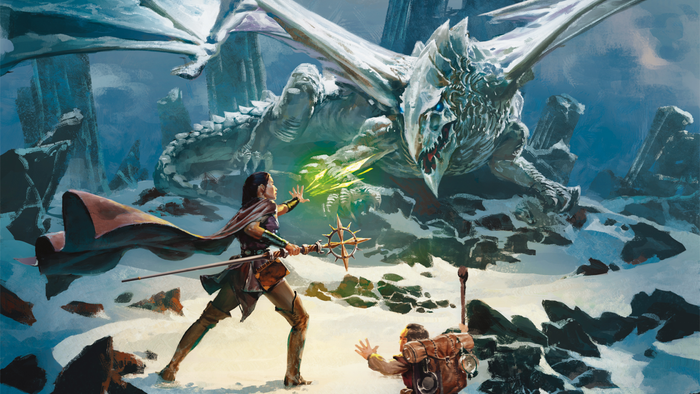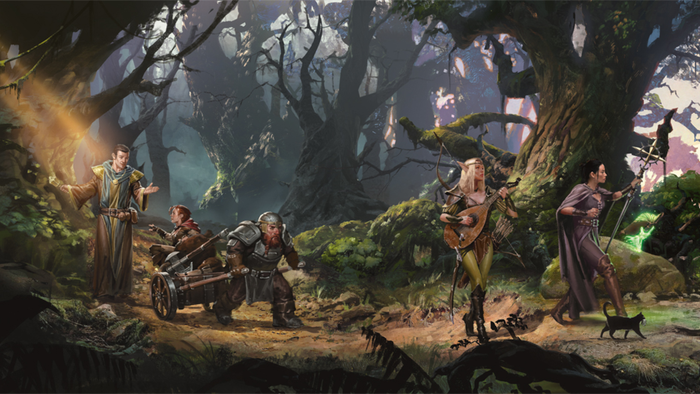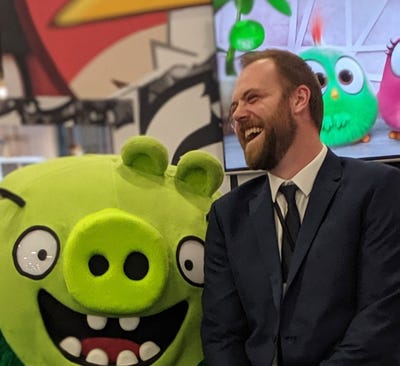Dungeons & Dragons: Exploring Pop Culture’s Critical Hit
License Global rolls the dice with Wizards of the Coast and talks 50 years of Dungeons & Dragons.

At a Glance
- Unlocking the infinite potential of the human imagination
- Bringing the property to life in new and exciting ways
- Dungeons & Dragons Historical Timeline
Widely considered the founders of gaming and fantasy roleplay, game designers, Gary Gygax and David Arnesen, first published Dungeons & Dragons (D&D) in 1974. D&D utilized polyhedral dice, graph paper and pencils to unlock the infinite potential of the human imagination, where a team of players navigates the world of a lead storyteller or Dungeon Master. What began 50 years ago evolved with each new edition and fan, transforming into an experience where nothing is impossible. As the game grew, so too did its place in the cultural zeitgeist, going from cult hit to global phenomenon thanks to the cultural revival of the game in mainstream media and the rising power of kidult culture.
Outside of the handbooks and D20s, the Dungeons & Dragons brand is growing globally through omnichannel engagement programs covering everything from video games to streaming channels and movies, bringing new players into its global community.

Baldur’s Gate 3, Dungeons & Dragons
“Popular culture’s adoption of fantasy in general and the roleplaying possibilities of Dungeons & Dragons specifically due to writers, showrunners and creative people in Hollywood portraying the game so compellingly in Netflix’s ‘Stranger Things’ or ABC’s ‘Ghosts’ has contributed to a growing audience,” says Ann Earp, head, category licensing and business development, Wizards of the Coast. “But the real success of D&D comes from the writers and designers at Wizards of the Coast making the game accessible for everyone. The emergence of digital tools like ‘D&D Beyond’ and infinite hours of video content on YouTube and Twitch have made it easier than ever to get into the game.”
When Hasbro acquired Wizards of the Coast in 1999, ownership of the Dungeons & Dragons intellectual property came with it, beginning a new era of investment in the players, the community, the game (now in its fifth edition) and the property.
“The potential for Dungeons & Dragons was always present,” says Earp. “But the last few years have seen leaps in the game’s core design that have removed any roadblocks to play. Everyone loves getting together and rolling dice with friends and family; now, we see even more potential to bring tabletop roleplaying to more folks. Hasbro and eOne brought ‘Dungeons & Dragons: Honor Among Thieves’ to life because the company believed in the power of the brand to bring fans together.”
Dungeons & Dragons first hit the entertainment market with Mattel’s Intellivision, spawning a long and globally celebrated list of video game titles with table-top’s sister sub-culture, gaming. From “Pool of Radiance” (1988) to milestone releases such as “Baldur’s Gate” (1994), “Icewind Dale” (2000) and “Neverwinter Nights” (2002), Dungeons & Dragons was licensed into countless titles and inspired an entire genre of fantasy roleplaying games (RPG), ultimately paving the way for Larian Games to launch the Game of the Year Award-winning “Baldur’s Gate 3” in 2023.
“‘Baldur’s Gate 3’ from Larian Studios is a fantastic video game that translates the experience of playing in an expertly woven story with fully realized cinematics and wonderful voice acting,” says Earp. “Combine that with the breakout success of ‘Dungeons & Dragons: Honor Among Thieves’ reception from critics and fans alike, making 2023 a banner year for the brand. We expect all that exposure to drive more fan engagement to other aspects of the business, such as the wonderful ‘Heroes’ Feast Flavors of the Multiverse: An Official D&D Cookbook’ and the original TV programming debuting on the D&D Adventures FAST channel now such as ‘Faster, Purple Worm, Kill, Kill.’”

“Heroes’ Feast Flavors of the Multiverse: An Official D&D Cookbook.”
Gaming is a powerful arm of entertainment adaptations, but thanks to the rebooted movie franchise – which began with “Dungeons & Dragons: Honor Among Thieves” (2023) – the potential to bring the property to life in new, exciting ways, not to mention engaging millions of new fans, is a genuine driver for the future of the brand. Dungeons & Dragons, after all, is a multigenerational brand steeped in storytelling and, most importantly, built on a foundation of flawless fan engagement.
Not only is nostalgia and escapism a core audience driver, but Dungeons & Dragons is becoming ever-increasingly future-proof, combining engagement in the millions using their imagination to play with friends, make memories and spend time crafting intricate campaigns, with the countless audiences immersing themselves in the video games and blockbuster touchpoints.
This year has brought a new focus on the brand and created an opportunity for Wizards of the Coast to strategize boundless growth over the next 50 years.

“Volo’s Guide to Monsters” artwork.
“Now that so many people understand the joy of playing Dungeons & Dragons with their friends and family, we’re going to capitalize on that by offering more expressions of the brand by partnering with exciting firms to bring that joy to more fans,” says Earp. “One way we’re doing that is finding more multigenerational expressions so that D&D can be shared with the whole family. We’re also committed to bringing Dungeons & Dragons to more parts of the world by capitalizing on the brand’s international recognition. So much of Dungeons & Dragons has already been subsumed into popular culture through gaming or geek culture. Concepts like hit points, leveling up or rolling a critical hit all come from Dungeons & Dragons and are becoming more mainstream, not to mention iconic monsters like the mind flayer, the beholder and dragons with unique characteristics according to their color. There are multiple genres Dungeons & Dragons can explore more, like horror or mystery, as they become a bigger part of pop culture. Vampires, werewolves and detectives – we’re doubling down on expanding what makes Dungeons & Dragons cool by creating new modern icons. We want the next adventuring party of friends introduced to Gen Y fans to look and feel like them even more.”
According to Earp, the fan base shares a commonality in being creative, engaged and keen to express its identity as fans through products, friends, podcasts, social media or streaming channels. As that fan base grows, so does the potential for licensed extensions. Capsule col[1]lections, beer and beverages, toys and more have hit the market, catering to the breadth of ages, interests and audiences engaged with the brand.
“Dungeons & Dragons is already a household brand name recognizable worldwide,” says Earp. “In the future, Hasbro sees more entertainment showing expressions of Dungeons & Dragons from different sub-genres of fantasy to captivate even more fans and drive engagement with the brand in new ways. We see more digital expressions coming soon, from expanding the digital toolset on D&D Beyond to encompass online play in a virtual tabletop to more digital video games expanding on the success of ‘Baldur’s Gate 3.’ The next 50 years of Dungeons & Dragons will be glorious for fans who’ve been playing since 1974 to fans who haven’t even been born yet.”
As the Dungeons & Dragons brand grows over the coming years with new iterations of entertainment undoubtedly set for release, Wizards of the Coast and Hasbro are planning to seize the moment and take the initiative to build a brand for ages, “So sayeth the wise Alaundo.”

Image from Dungeons & Dragons Essential Kit.
Dungeons & Dragons Historical Timeline
1974
Men & Magic, Monsters & Treasure and The Underworld & Wilderness Adventures began the D&D legend with only three classes, four races and a handful of monsters
1975-1976
Greyhawk, Blackmoor, Eldritch Wizardry and Gods, Demi-Gods & Heroes expanded the rules, classes (thief), monsters and spells
1977-1979
D&D rules were changed and reorganized into Advanced Dungeons & Dragons with three core rulebooks (Monster Manual, Player’s Handbook, Dungeon Master’s Guide)
1988
The release of “Pool of Radiance” was the first licensed D&D video game (CRPG) published by SSI for the Commodore 64 and DOS systems. Ports to the Mac, Amiga and Nintendo platforms followed, as did a series of “Gold Box” games beloved by CRPG fans
1989
Drizzt Do’Urden first appeared in the novel, “The Crystal Shard,” by R.A. Salvatore
1989–1993
A D&D 2nd Edition featured new rules and classes with updated core rulebooks, which included an expanded Monstrous Compendium; THACO was introduced
1994
Planescape first released
1997
Wizards of the Coast acquired TSR
1998
“Baldur’s Gate” is released. Created by the founders of BioWare, this isometric CRPG utilized the nascent internet gaming community when it allowed fans to play together online
1999
Hasbro purchased Wizards of the Coast
2000
D&D 3rd Edition launched and leaned into the d20 system and encouraged tactical gameplay; sorcerer class added
2002
“Neverwinter Nights,” the follow-up to BioWare’s CRPGs was released, notable for shipping with the “Aurora” toolset allowing creators to build their own stories and worlds
2003
Revised version of 3rd Edition (called 3.5) added small rule changes, more balancing
2008–2010
D&D 4th Edition included multiple volumes of the core rulebooks; overhauled the game system to include at-will, encounter, daily powers; Acquisitions Incorporated began its online adventures in a podcast (2008); D&D co-creator Gary Gygax (2008) and Dave Arneson (2009) passed away
2014
D&D 5th Edition simplified and streamlined play; Starter Set featured Lost Mine of Phandelver adventure
2017
Xanathar’s Guide to Everything expanded play with new subclasses, spells, DM tools, won Origins Award for Best RPG Supplement
2018
The first D&D in a Castle event takes place in France, where 36 guests spent a weekend in a medieval castle playing D&D with game designers and celebrities weaving tales in a fantastic setting
2020
Tasha’s Cauldron of Everything brought in new character options, magic spells and items and expanded rule options
2022
Mordenkainen Presents: Monsters of the Multiverse pulled together more than 250 monster updates and 30 playable races into one sourcebook
2023
“Dungeons & Dragons: Honor Among Thieves” opened to a No. 1 box office weekend showing: “Baldur’s Gate 3” by Larian Studios won multiple Game of the Year awards
2024
D&D celebrates 50 years; releases 2024 Core Rules Update making the World’s Greatest Roleplaying Game even better and easier to learn
This article was featured in the February 2024 issue of License Global.
Read more about:
Dungeons & DragonsHasbroWizards of the CoastGlobalLicense Global OriginalFebruary 2024About the Author(s)
You May Also Like








